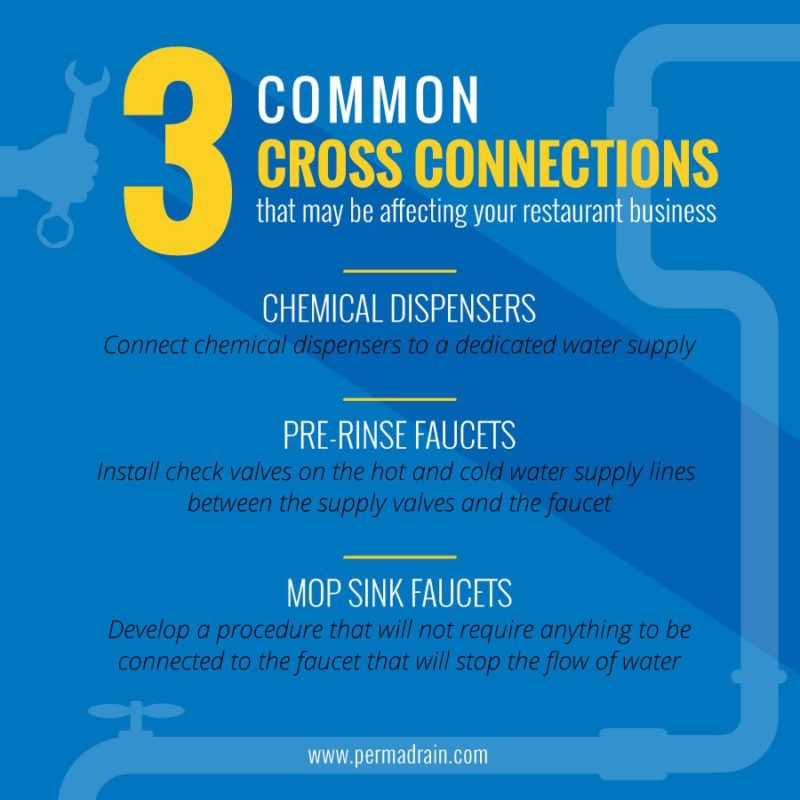No products in the cart.
Drain Protection, Plumbing, Tips
Cross Connections Might Be Affecting Your Restaurant
What is a cross connection, and how can one affect your restaurant or food service business?
A cross connection is any physical connection between two otherwise separate piping systems, whereby water may flow from one system to the other. Unfortunately, cross connections are all too common in restaurant kitchens. They usually occur between the hot and cold water systems causing problems like low temperatures at dishwashers or hot water coming out of faucets when cold water should. Fortunately, with a little understanding, these potential problems can easily be prevented at a reasonable cost.
Let’s go over a few common cross connections which can cause headaches, unnecessary expenses, and health hazards:
CHEMICAL DISPENSERS:
While chemical dispensers connected to your plumbing system are a great benefit and can save a lot of money, they are also one of the most common causes of cold and hot water lines being crossed. When the water supply for a chemical dispenser is connected to a faucet and an employee leaves the hot and cold handles turned on, a cross connection has instantly been created. It is always best to connect chemical dispensers to a dedicated water supply. If one is not available, a plumber can usually add one fairly easy from an existing supply line for a faucet.
PRE-RINSE FAUCETS:
Pre-rinse faucets also cause many problems for restaurants often leaving them and their plumbers scratching their heads. When an employee turns the hot and cold handles on to wash dishes, they often get left on. In many cases, we find that pre-rinse faucets never get turned off and pressure is left on the hose at all times. It’s a good practice to teach employees to turn off all faucets while not in use to prevent a flood from occurring. Hoses can burst during the middle of the night while no one is present. The best solution to prevent a cross connection at pre-rinse faucets where hoses with sprayers exist is to install check valves on the hot and cold water supply lines between the supply valves and the faucet. I recommend using spring loaded check valves, but there are a variety of options available. Check with your local plumber to make sure the check valves you are using meet local plumbing codes and offer the drain protection you need.
MOP SINK FAUCETS:
Mop sink faucets often have hoses and splitters connected to them causing a cross connection when the faucet is left on. They can be a little more difficult to install check valves since there are no visible supply lines on wall mounted mop sink faucets. The water supply usually has to be turned off to add the check valves to the supply lines in the ceiling or basement. Sometimes the best solution for mop sinks is to come up with a procedure that will not require anything to be connected to the faucet that will stop the flow of water from the faucet.
While there are other situations that can cause cross connections between hot and cold water lines, this covers the majority of problems that restaurants experience. As a simple rule of thumb, if something can stop the water from coming out of a faucet while the handles are left on, it creates a cross connection. The severity of the problem in your facility can vary greatly depending water supply, type of water heaters, or other conditions. The problem is often at its worst when restaurants are the busiest. Flush valves on toilets and urinals demand a lot of water during peak times which drops the cold water pressure allowing the hot water to enter the cold water lines.
If you face this problem, hopefully this information can help you identify the source of the problem. You can then easily train your staff to keep faucets off when not in use or get a plumber to make modifications without going through expensive troubleshooting costs. Finally, when calling your commercial plumbing contractor for help with this problem, be sure to ask for a technician experienced with cross connections. This will help keep the labor cost down on repairs.
